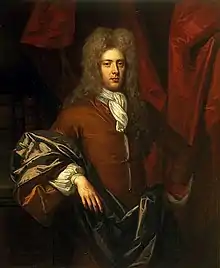The Earl of Findlater | |
|---|---|
 James Ogilvy, 4th Earl of Findlater. | |
| Keeper of the Great Seal of Scotland | |
| In office 1713–1714 | |
| Monarch | Queen Anne |
| Preceded by | The Marquess of Tweeddale |
| Succeeded by | The Earl of Seafield |
| Lord Chancellor of Scotland | |
| In office 1702–1708 | |
| Monarch | Queen Anne |
| Preceded by | The Earl of Marchmont |
| Succeeded by | David Steel (as Presiding Officer of the Scottish Parliament) |
| Lord High Commissioner to the General Assembly of the Church of Scotland | |
| In office 1703–1704 | |
| Monarch | Queen Anne |
| Preceded by | The Earl of Marchmont |
| Succeeded by | The Lord Ross |
| Personal details | |
| Born | 11 July 1664 |
| Died | 19 August 1730 (aged 66) |
| Spouse | Anne Dunbar |
| Children | 4, including James |
| Parent(s) | James Ogilvy, 3rd Earl of Findlater Lady Anne Montgomerie |
James Ogilvy, 4th Earl of Findlater and 1st Earl of Seafield, KT, PC (11 July 1664 – 19 August 1730) was a Scottish politician, prominent during the reign of Queen Anne. He was created Earl of Seafield in 1701 and was an active supporter of the 1707 Act of Union.
Life

Findlater was the second son of James Ogilvy, 3rd Earl of Findlater, of Clan Ogilvy, and Lady Anne Montgomerie, a daughter of Hugh Montgomerie, 7th Earl of Eglinton.
He was elected to the Faculty of Advocates in 1685, and was a Commissioner to the Parliament of Scotland for Cullen, Banffshire from 1681 to 1682 and from 1689 to 1695. Although in the Convention Parliament of 1689 he had spoken for James II, he took the oath of allegiance to William and Mary, and after filling some minor official positions he was appointed to senior roles.[1] Upon his royal appointment as Secretary of State in 1696 he relinquished his representation of Cullen and continued in parliament instead by right of his office. Findlater was Solicitor General for Scotland from 1693, Lord Chancellor of Scotland from 1702 to 1704 and from 1705 to 1708, Secretary of State from 1696 to 1702 and joint secretary from 1704 to 1705. He was elected a Fellow of the Royal Society in 1698.[2]
Findlater was created Viscount Seafield in 1698 and Earl of Seafield in 1701. He was a Commissioner for the Union from 1702 and an active promoter of the Union from 1706. He served as first Lord Chief Baron of the Scottish Court of Exchequer, established by the Act of Union. By 1713 his views on Union had changed and he moved for its repeal.
He sat in the British House of Lords as a Scottish Representative Peer from 1707 to 1710, from 1712 to 1715 and from 1722 to 1730. Findlater was admitted to the Privy Council of Great Britain in 1707 and was appointed Lord Chief Baron in the Court of Exchequer in 1707. In 1711 he succeeded his father as fourth Earl of Findlater.[1] He served as Keeper of the Great Seal of Scotland from 1713 to 1714.
He died in August 1730, aged 66, and was succeeded by his son James Ogilvy, 5th Earl of Findlater and 2nd Earl of Seafield.
Family
Lord Findlater married Anne Dunbar, daughter of Sir William Dunbar, 1st Baronet, in 1687. They had the following issue:[3]
- James Ogilvy, 5th Earl of Findlater and 2nd Earl of Seafield (1689–1764), succeeded.[4]
- Hon. George Ogilvy (1690–1732), died unmarried.
- Lady Elizabeth Ogilvy (1692–1778), married Charles Maitland, 6th Earl of Lauderdale, and had issue.
- Lady Janet Ogilvy (1695–1720), married Hugh Forbes of Craigievar, without issue.
References
- 1 2 Chisholm, Hugh, ed. (1911). . Encyclopædia Britannica. Vol. 24 (11th ed.). Cambridge University Press. p. 533.
- ↑ "Fellows details". Royal Society. Retrieved 18 June 2019.
- ↑ G.E. Cokayne; et al: The Complete Peerage of England, Scotland, Ireland, Great Britain and the United Kingdom, Extant, Extinct or Dormant, new ed. (1910-1959; reprint in 6 volumes, Gloucester.: Alan Sutton Publishing, 2000), volume V, p. 377
- ↑ Balfour Paul, Sir James (1904). The Scots Peerage. Vol. IV. David Douglas. p. 38.
External links
- Article with biographical notes
- Lee, Sidney, ed. (1895). . Dictionary of National Biography. Vol. 42. London: Smith, Elder & Co.